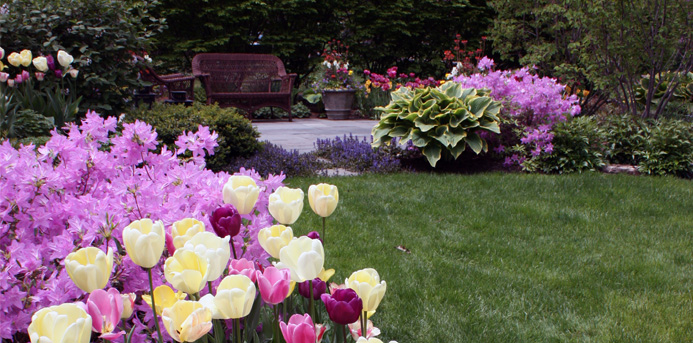Spring has finally arrived and it’s time to prepare your garden for the upcoming season. Here are some tips to make this your most successful garden ever!
Perennial Cleanup
Try to cut back perennials before the days get too warm and new growth starts emerging in last year’s stem residue. You may need to remove winter-tattered foliage (“deadleafing”) rather than doing a to-the-ground cut back on “evergreen” perennials like Bergenia, Heuchera and Hellebores, for example. However, don’t cut back creeping Phlox, Oriental poppy and Iberis, or you may lose the plants.
Perennial Support
Don’t forget last year’s promise (to yourself!) to get the cages, hoops and “grow-through” plant supports on early. Gardening is much more fun when you’re proactive with this very important task. This may even apply to shrubs. If ‘Annabelle’ Hydrangeas have flopped (literally) in the past, try containing them early so their beautiful ivory heads aren’t resting on the ground this year.
Spring Bulbs
Deer and rabbits won’t touch daffodils. Tulips, however, are a three-course meal. Foliage, buds, flowers—all fair game. While you can erect physical barriers, that sort of negates the idea of a beautiful color display to welcome spring. However, there are a number of great repellents that can be applied so your garden can look like la slice of Holland. Don’t forget to fertilize your bulbs this spring, either as they emerge or as they finish flowering.
Everything’s Coming Up Roses
For rose bushes, don’t be tempted to remove winter protection too early. Also, don’t be afraid to prune roses (other than climbers, species roses and some shrub roses) hard. What “rosarians” say about pruning hard and getting more new basal branches is true. You’ll also be removing over-wintering black spot spores that lurk in old leaves and canes.
Soil Preparation
Spring cleanup and planting is the perfect opportunity to enhance your soil, especially if your garden has dense clay. Take this time to top-dress annual, veggie and perennial beds with compost, leaf mulch or dehydrated manure. This can be cultivated in or in the case of new beds, rototilled or spaded in. After a couple of years this TLC soils will start showing big structural improvements-and your plants will respond accordingly.
Weed Prevention
Many weeds (especially annuals, the ones that grow for only one season) can be thwarted with pre-emergent weed control. After you’ve done whatever raking or cleaning you’re going to do in beds, apply the granules; water or lightly cultivate the granules into the soil. Understand that you’re preventing weeds, not killing those that have germinated and are growing. Read directions carefully and fully BEFORE application to get maximum results!
Mulch
The tests have been done and the results universally show that virtually all plants perform with better, more vigorous growth if they’re mulched. Spring is the time to get that organic matter down (leaf mulch, cotton burr compost, shredded pine or hardwood bark, etc.). Remember you’re mulching roots, not stems. So try and leave mulch-free zones immediately adjacent to annual and perennial stems, and “trunks” of trees and shrubs. While mulch will dramatically deter weed growth you can apply pre-emergent weed control to the surface of mulches if you like.
3132 Lake Avenue, Wilmette | 847.256.0561 | chaletnursery.com


